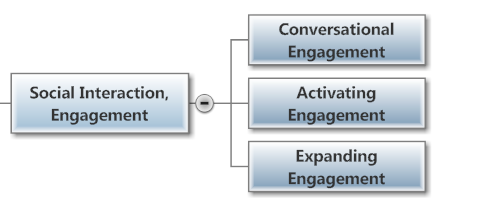Engagement
 The CyTRAP BlogRank Engagement Score (you are here) is a comment-analysis algorithm that assigns a numerical weighting to how people intereact / engage with a blog’s content.
The CyTRAP BlogRank Engagement Score (you are here) is a comment-analysis algorithm that assigns a numerical weighting to how people intereact / engage with a blog’s content.
The Engagement/Social Interaction Score ranges from 0 (worst) through 100 (best). In this context, social interaction / engagement describes the level of being able to evoke a response, feedback, engagement, reaction from the readers of one’s blog.
The CyTRAP Engagement or Social Interaction Score is part of what makes up the CyTRAP BlogRank.
The CyTRAP BlogRank is calculated by using SIX indices: Headline Score, Text Complexity Score, First Impressions Score, Knowledge Transfer Score, Online Word of Mouth Marketing (WOMMA) made up of the Ripple Score (Google+, Twitter AND Facebook) and the Engagement/Social Interaction Score (you are here).
In short, we calculate the z-score for each of the indicators explained below BEFORe we calculate the indes. Thereafter these numbers (i.e. z-scores) are then used in the following way: Sum[(A) + (B) + (C) + (D) + (E)]/5 = Engagement Score that ranges from about -2 to + 2 (PS. A negative z–score means that the original score was below the mean).
This score is then re-scaled in order to rank your blog compared to the others (1 through 100 for the best).
The CyTRAP BlogRank Engagement Score we can then use to rank your blog compared to others. We calculate these numbers over a 90 days – 3 months period for each blog and chart the performance.
A – Adjusted Engagement Score (new)
Avinash Kaushik wrote Blog Metrics: Six Recommendations For Measuring Your Success where he suggested as one of the six measures the following:
Comment Ratio = Number of Comments from visitors / # of Posts during period (e.g., over 3 months or about 90 days)
Here visitor comments exclude the author’s replies.
Fact: Ideally we have a number above 1.0 that means more comments than blog posts in the period. Those that have comments disabled get a 0 for adjusted engagement score
Bonus system
As part of the adjusted engagement score, people that have comments enabled on their blog get ten points added to their score under point A.
B – Conversational Engagement Score
Avinash Kaushik‘s measure can be refined further by putting visitor comments in relationship to author replies. Reason being that commenters want replies and a conversation does not happen if nobody seems to be listening and replying or at least acknowledging your thoughts. Hence, we use:
Conversational Engagement = SUM [(Number of Author Replies / Number of Comments from Visitors) for each blog post] during period (e.g., over 3 months or about 90 days).
Here we hope to get a ratio of upwards to one. In practice this means that the author tries to reply to each comment left by a visitor. Of course this is not always needed nor feasible. Generally, 1 is the top score here (i.e. author replies to each commenter’s entry).
Sometimes the score here may go higher than 1 if the author puts in one or two replies to a comment. For instance, she discovers more information later and adds another comment with a chart to the previous reply – thus having replied twice to the same comment.
Example: 12 replies by author and 13 visitor comments = Conversation Ratio 0.923
Bonus system
As part of B – conversational engagement score – authors that reply to readers comments (i.e. to 50 or more percent of these) get five points added to their score under point B.
C – Activating Engagement Score
This measures how people tend to reply and comment about blog posts during the period assessed (3 months).
Activating Engagement = SUM [ Number of words in all comments for all blog posts during this period – # of all comments x 25 words / # of words blogged in the blog post during period (Minimum used here is 400 words per blog post) (e.g., over 3 months or about 90 days) ] .
If a blog comment is less than 25 words, engagement is questionable. Even if somebody feels a blog post is great, he or she should explain why. Most importantly, it takes a few words to add something insightful with a comment. Such type of comments are almost always more than 100 words. Just try yourself and keep score how many words you need to write a comment that adds value to the blog post.
All else considered held constant, many comments should result in a higher score since those add up to many words. One would hope that the score is 1 or higher. Of course, longer blog posts tend to have fewer comments simply because it takes more effort including time to add a substantive comment to a blog post of high quality (see also examples below from Napier’s blog as well as Mashable.
Example: 5950 words in comments (visitors and author’s) divided by 6600 words blogged by author during period (e.g., 90 days) = Activating Engagement Score = 0.915
D – Expanding Engagement Score
Here the focus is on depth. If an idea resonates with me I will put in some effort to write a comment. For instance, disagreeing with a blog post also requires one to fine-tune one’s argument and spend 15 to 30 minutes to formulate a well crafted reply. In short, writing a thoughtful and useful abstract of 100 words is tougher than just saying: “thanks I agree, great post.”
Sometimes there might be hundreds of comments from readers for a blog post. Unfortunately, they mean nothing as most of them are one or two words with a link back to the commentator’s blog.
The above type of comments mean little if anything in terms of influence. They are a simple reflection of a blog’s amount of traffic. However, if we look at the comments on some blogs, the can be mini essays. Accordingly, this mini-essays though fewer in number, are worth far more.
Expanding Engagement = SUM [ Total # of words in all comments for all blog posts during the period (e.g., over 3 months or about 90 days) – (# of all comments during period x 25 words) ] / # of comments during period (e.g., over 3 months or about 90 days).
Example: 1000 words of comments for all blog posts during the period – 750 [ for each comment (30 in total for all blog posts during this period) x 25 words ] / 10 comments for that blog entry gives us a Expanding Engagement Score of 25.00 for this blog entry. This is done for all blog entries during this period and summed up as shown above.
Fact: Comments below 25 words rarely add beef to the discussion, such as:
Comment on Carla Napier’s blog (depending on counting between 7 to 10 words): “Nice blog Carla…keep going girl!!! www.daybydayfitfashion.com“
Generally, when comments are above 25 words, they start adding insights to the blog post they refer to, such as:
1st paragraph of a comment (more than 75 words) on Mashable = 31 words: “Spamming has become a business which is only expanding with time. Recently I had received tweets about getting 1000s of followers or Facebook likes. This kind of marketing is really bad.”
How do we calculate the final score
In short, we first calculate the raw score for the above four indicators. If a blog has comments disabled (i.e. you cannot leave a comment), you get a zero for the Engagement Score (see equation below).
Using the raw scores we calculate the z-score for each of the above indicators. Thereafter these numbers (i.e. z-scores) are then used in the following way: Sum[(A) + (B) + (C) + (D)]/4 = Engagement Score that ranges from about -2 to + 2 (PS. A negative z–score means that the original score was below the mean).
Based on statistical logic, for a composite standardised (z) score, individual variables (that comprise this composite) must be transformed before forming the composite.
The z-scores for the above indicators are added up to get an overall z-score. This information is calculated into an overall score. Click here to find out how we process the raw data.
The actual CyTRAP BlogRank Engagement number is used in the CyTRAP BlogRank algorithm to help determine the CyTRAP BlogRank of the blog, website or other social media effort being benchmarked.
At this point, the overall scores are compared and rescaled using 100 as the top score.


Pingback: Are Google and Yahoo failures? » Social sharing drives 1 out of every 4 online shoppers to purchase, major feature updates, drive higher engagement, ComMetrics Footprint, ComMetrics Footprint, Ripple Score, get access to most of these features, but only
Pingback: Die 10 besten Karriereblogs der Schweiz » » Dr KPI: ROI, Efficiency, KMU, Kennzahlen, Strategien
Pingback: Top 50 UK fashion blogs » Update 2013-09-03, atlantic-pacificblogspotcom , February March 2014, Who are the top fashion bloggers, criteria do fashion magazines use, How does a fashion brand decide, Keywords, Top 50 US fashion blogs » ComMetrics | measu
Pingback: Top 50 US fashion blogs » February March 2014, Who are the top fashion bloggers, criteria do fashion magazines use, How does a fashion brand decide, Keywords, Top 50 US fashion blogs you are here, Top 50 UK fashion blogs, Top 50 Modeblogs in Österreich
Pingback: Top 50: Modeblogs in Österreich » » Dr KPI: ROI, Efficiency, KMU, Kennzahlen, Strategien